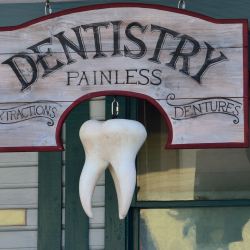The New York Times’ “Well” section recently published an article entitled, “What Dentists Wish You Knew,” which listed five points. We found them to be a somewhat odd and incomplete collection. We list the Times' offerings, with our commentary and some bonus suggestions of our own.

Here are the Times' suggestions:
1. “Your gums should not bleed when you floss”
Partly true. Although inflamed or infected gums bleed excessively when they are traumatized such as by dental floss, even normal gums may bleed a bit during normal brushing or flossing. Flossing should be performed in a consistent and non-traumatic way. In addition, we endorse the use of a device that directs a high-pressure stream of water between teeth to ensure that all food particles are removed.
2. "Step away from the charcoal toothpastes"
We agree. Toothpastes containing powdered activated charcoal, marketed as a natural teeth whitener, may be trendy but they have no demonstrated advantages and several drawbacks. The latter include excessive abrasiveness that can cause tooth hypersensitivity, discoloration, and, potentially, loss of enamel. As the Times’ article notes, no charcoal toothpastes have received the A.D.A. Seal of Acceptance, which has been the mark of dental product safety and efficacy for over 90 years.
3. "You don’t need an electric toothbrush”
Well, it is true that you don’t need an electric toothbrush, but we think its use promotes oral health by making the time you spend brushing more efficient and easier. A large, longitudinal study in Germany found that the use of an electric toothbrush “has a long-term protective effect on the oral health in terms of reduced probing depths, clinical attachments and number of teeth lost” – in other words, clear benefits in terms of fewer teeth extracted and reduced periodontal disease over the long term.
4. “The health of your mouth is linked to the health of your body”
No argument from us about that! Tooth decay remains one of the major public health concerns for developing and industrialized countries alike, according to the World Health Organization. It is one of the most common chronic problems in the United States, where most adults will have at least one cavity in their lifetime. Decay causes inflammation in surrounding gum tissue, abscesses, and eventually, tooth loss. In addition to taking a significant toll on quality of life, decay and periodontitis have been linked to an increased risk of cardiovascular events, systemic infections such as endocarditis, and complications in pregnancy. Studies have shown an association between periodontitis and premature births, preeclampsia, and gestational diabetes.
5. “Don’t get high before your dental exam”
We wonder whether this would be high (pardon the expression!) on the list of things that most dentists would like to tell patients, but it is valid. A study of patients undergoing minimally invasive endoscopic procedures found that before administering sedation, knowledge about the use of cannabis products can be important for planning patient care and assessing both medication needs and possibly increased dosage requirements for sedatives. It’s a reasonable extrapolation to patients undergoing dental procedures.
We have a few points to add:
1. The use of electric handpieces and hard tissue lasers in dental procedures
Handpieces are precision medical devices used to remove tooth tissue efficiently, to prepare cavities for restoration and/or crowns, and to section a tooth during surgery. The development of electric handpieces has revolutionized dental procedures by reducing noise and increasing efficiency. They produce less noise compared to traditional air-driven versions and provide more consistent torque and speed, resulting in more precise and efficient procedures.
Hard tissue lasers are another innovation in dentistry which allows dentists to remove cavities and perform other dental procedures with less discomfort and faster healing times for patients. The use of lasers can minimize the need for anesthesia, reduce bleeding, and decrease postoperative swelling.
These advances in dental technology have made dental visits more comfortable and less intimidating for patients, reducing their reluctance to obtaining the care they need for oral health.
2. Avoid unproven techniques, such as oil pulling and ozone therapy
“Oil pulling,” or "oil swishing," a traditional Indian practice that involves swishing oil in the mouth to remove bacteria and improve oral health, has gained popularity in recent years. Although it may provide similar benefits to flushing the mouth with water or using a mouth rinse, such as reducing plaque and food debris next to teeth, there is no scientific evidence that it is effective, and it should not be considered a substitute for routine oral healthcare.
Ozone therapy, another unproven dental technique, involves using ozone gas to (supposedly) disinfect teeth and treat oral infections. While ozone does have antibacterial properties, the long-term safety and efficacy of ozone therapy in dentistry have not been well-established. More research is needed before ozone therapy can be considered to be safe and effective.
It is crucial for patients to be wary of unproven dental techniques and practices, and always to rely on licensed and reputable dental practitioners who employ evidence-based practices to ensure the best possible outcomes.
3. Debate over mercury fillings and their removal
Mercury fillings, also known as amalgams, have been a subject of debate among dental professionals and patients due to concerns about potential health risks associated with mercury exposure. Although amalgam fillings are composed of a mixture of metals including mercury, they have been widely used in dentistry for over a century because of their durability, affordability, and ease of application.
The American Dental Association (ADA) and other reputable health organizations maintain that amalgam fillings are safe and effective for use in dental restorations. The consensus in dentistry is that the small amounts of mercury released from these fillings are not enough to cause health problems for the vast majority of patients. However, some patients and practitioners advocate the removal of amalgam fillings due to concerns about mercury toxicity.
It is important to note that removing amalgam fillings can be an invasive and costly procedure, and can actually expose the patient to higher levels of mercury as the fillings are removed. In some cases, removal might be necessary due to damage, decay, or other dental issues, but the decision to remove amalgam fillings should be made on a case-by-case basis, taking into consideration each patient's unique circumstances and needs.
4. Chewing sugar-free gum promotes dental health
Saliva provides natural immune support and protection of a healthy oral biome. The pH of saliva, however, varies from individual to individual. More acidic saliva can increase the occurrence of cavities while a more basic pH prevents them.
Perhaps surprisingly, keeping a person’s salivary pH favorable can be as simple as chewing sugar-free gum on a regular basis. It has been found experimentally that, “During prolonged chewing gum use, both salivary flow rates and pH remained significantly above the values for unstimulated saliva.”
An article in the Journal of the American Dental Association summarized the results of seven international clinical trials that have tested gum’s beneficial salivary effect on cavities. In the first test, children aged 8 through 12 in a Danish school were given sugar-free gum to chew after breakfast and lunch over the course of two years. Their teeth were X-rayed and compared with a control group from a second school where no gum chewing took place. The result was a statistically significant drop in cavities among the gum chewers.
Follow-up studies appear to show that gum-chewing offers more than simply the short-term stimulation of saliva, as the benefits were found to for years after the gum-chewing was discontinued. The researchers who conducted one of the original studies held a five-year reunion for participants and found that the difference between the gum-chewing and control groups had continued to increase in favor of the former group.
Shiv Sharma is a practicing dentist and owner of Palo Alto Oral Health in Palo Alto, California.
